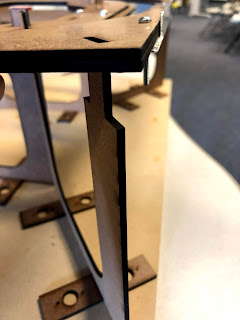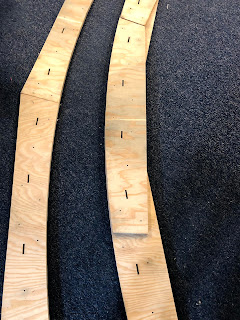Team Blog #3
September 25, 2019
Presentation Recap:
This week the Small Scale team presented solutions for improving the guideway, bogie, and controls. The bogie will be improved by changing the switch mechanism to latch onto the third rail to prevent the bogie from falling through any gaps in the guideway as shown in Figure 1. The guideway will be improved by laser cutting plywood, which would allow for precision among each track piece.
 |
| Figure 1. Bogie latching onto right side of third rail. |
 |
| Figure 2. Snap-Fit design for the two-piece bogie. |
In addition, the controls team will make an iOS phone application developed in Xcode to control the bogie. The bogie will use a PixyCam to determine each direction to take and for locating each station. The PixyCam and an ultrasonic sensor will be used to prevent the bogies from colliding with each other.
Agenda for this week:
After discussing with Professor Furman, the guideway will need to be attached in a way that allows for the pieces to be easily interchanged. The design will need to be similar to Bill James mini scale track as shown in Figure 3 and Jacques design, shown in Figure 4.
The holes in the plywood as shown in Figure 5 will be used for alignment and bolting down each piece.
The controls team will research into developing the iOS app and working with the PixyCam as shown in Figure 6. More research will be done on each sensor used as well.
 |
| Figure 3. Bill James mini model track piece design square slot. |
 |
| Figure 4. Jacques 10 meter track design using plywood. |
 |
| Figure 5. Plywood precisely cut using Waterjet at Makerspace. |
The holes in the plywood as shown in Figure 5 will be used for alignment and bolting down each piece.
The controls team will research into developing the iOS app and working with the PixyCam as shown in Figure 6. More research will be done on each sensor used as well.
Next Steps:
The next steps for the Small Scale team are to continue designing components for the guideway and bogie in SolidWorks. As well as developing a sensor stack for the bogie's control system and researching into the processing power of the PixyCam.
The next steps for the Small Scale team are to continue designing components for the guideway and bogie in SolidWorks. As well as developing a sensor stack for the bogie's control system and researching into the processing power of the PixyCam.

Comments
Post a Comment